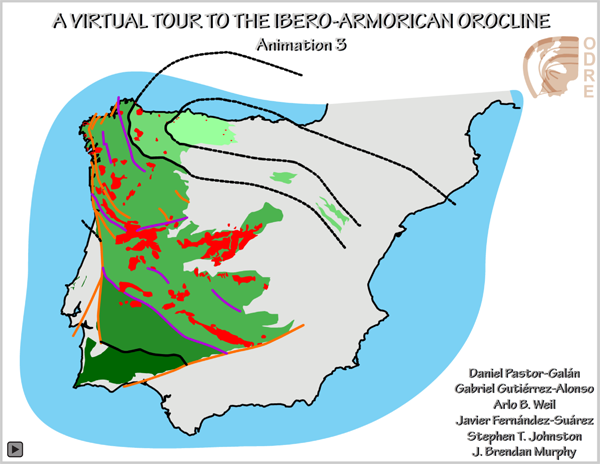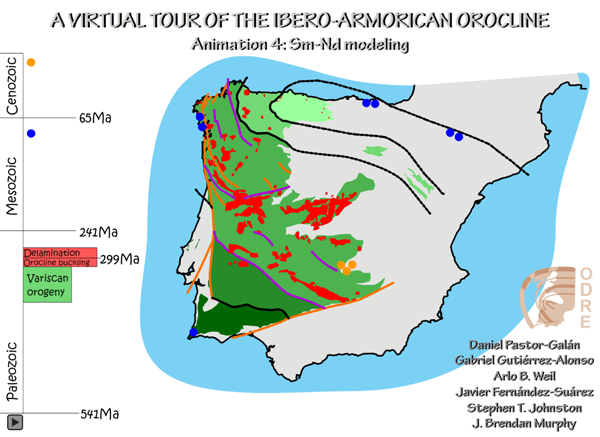Lithospheric Response
Do oroclines evolve as thick-skinned, lithospheric-scale structures, or, are they thin-skinned features that terminate along crustal detachments? This fundamental question relates to the three dimensional geometry of oroclines and is one of the most challenging in understanding orocline development. Key insights are provided by comparing crustal and lithospheric mantle responses to orocline development. Significant syn-oroclinal magmatism is interpreted to reflect a lower-crustal and lithospheric mantle response to thick-skinned buckling (Gutiérrez-Alonso et al., 2004, 2011a, 2011b, 2012). Synorogenic Variscan granitoid magmatism (345-315 Ma) accompanied the building and collapse of the Variscan orogenic belt (Fernández-Suárez et al., 2000). Post-orogenic magmatism comprises intrusive and volcanic rocks emplaced between 310 and 285 Ma, and which are penecontemporaneous with, and slightly post-date, oroclinal buckling (Animation 3; Gutiérrez-Alonso et al. 2011b). The post-orogenic magmatic record consists of mantle- and crustal-derived melts that show systematic changes in age, spatial distribution, geochemistry and petrology, and includes voluminous foreland magmatism in the Ibero-Armorican oroclineCantabrian Arc (Gutiérrez-Alonso et al., 2011b). Furthermore, the topographic response to this thermal event is recorded in the provenance and distribution of the Stephanian and Permian strata, and has been investigated through numerical modelling (Muñoz-Quijano and Gutiérrez-Alonso, 2007).
Animation 3 presents a thick-skinned interpretation of the Ibero-Armorican orocline, and illustrates the emplacement sequence of post-orogenic granitoids. Magmatism began in the orogenic hinterland with the intrusion of mantle-derived mafic melts from 310 to 305 Ma (Moskovian to Kasimovian in Animation 3). The early intruded mafic plutons in the hinterland are interpreted to result from decompressive mantle melting in the extending outer arc of the developing orocline. Thinning of the mantle lithosphere, and the resulting asthenospheric rise, would have elevated the geothermal gradient (see cross-section in the left side of Animation 3), which explains the subsequent melting of middle-upper crustal rocks, resulting in the intrusion of felsic magmas in the outer arc of the orocline between 305 and 295 Ma (Fernández-Suárez et al., 2000, Gutiérrez-Alonso et al., 2011b) (Kasimovian to Permian in Animation 3). A different (albeit intimately related) magmatic history characterizes the inner arc of the orocline, where magmatism did not begin until 300 Ma, and did not end until 285 Ma. Magmatism in the inner arc (i.e. the foreland) began with the intrusion of mafic rocks and granitoids as well as widespread bimodal volcanism that continued until 292 Ma. This phase of magmatism was followed by felsic, crustal-derived leucogranite magmatism that continued for another 7 Ma (Gutiérrez-Alonso et al., 2011b). The delayed onset of magmatism in the foreland is interpreted to reflect initial thickening of the lithospheric mantle in the Cantabrian Arc, forming an orogenic root that subsequently became gravitationally unstable. Delamination of the unstable root resulted in upwelling of hot asthenospheric mantle beneath the foreland, which explains the mantle-derived mafic magmatism and crustal melting (see cross-section in the left side of Animation 3).
Animation - Animation 3.

Thick-skinned interpretation of the Ibero-Armorican orocline illustrating the emplacement sequence of post-Variscan granitoids. Map-view in the right side display the timing of orocline formation and emplacement of granitoids while cross-section at the left side show the evolution of the lithosphere in depth. Thinning of the mantle lithosphere produce astenospheric upwelling resulting in the intrusion of mantle-derived mafic melts from 310 to 305 Ma (Moskovian to Kasimovian). This process elevated the thermal gradient explaining the subsequent melting of middle-upper crustal between 305 and 295 Ma (Kasimovian to Permian). On the other hand, initial thickening of the lithospheric mantle in the Cantabrian Arc, forming an orogenic root that subsequently became gravitationally unstable producing delamintion that resulted in upwelling of hot asthenospheric mantle beneath the foreland explain the magmatism in the inner arc of the orocline. This magmatism began with the intrusion of mafic rocks and granitoids from 300Ma. to 292Ma. This phase of magmatism was followed by crustal-derived magmatism from 292Ma to 285Ma.
Sm/Nd isotope systematics of mantle-derived rocks provide further evidence of mantle lithosphere involvement during orocline development (Gutiérrez-Alonso et al., 2011a; Ducea, 2011). Pre-oroclinal mantle-derived volcanic rocks indicate that the mantle lithosphere in NW Iberia was emplaced, or metasomatized, at ca. 1.0 Ga while post-oroclinal mantle-derived magmatic rocks yield neodymium model ages (TDM) of ca. 0.3 Ga (Animation 4). This contrasting signature indicates that orocline formation was coeval with removal of an older mantle lithosphere that was replaced by a new, juvenile mantle lithosphere. The syn-orocline mantle-derived melts were contaminated by crustal sources during orocline formation, and yield model ages that span the inferred age of the underlying pre-Variscan lithosphere and the new lithospheric mantle (Animation 4) (Gutiérrez-Alonso et al., 2011a).
Animation 4 is a synthesis of the geochemical evolution of the pre-, syn- and post-orocline mantle-derived rocks and shows our interpretation of their formation. For clarity, the animation has been slightly modified from the figure from Gutiérrez-Alonso et al. (2011a) removing the plume related CAMP magmatic rocks.
Structural, paleomagnetic, geochronologic and geochemical data constrain mantle replacement and orocline formation to have been coeval, and is consistent with interpretation of the two processes as being genetically linked. We conclude that buckling of the Ibero-Armorican orocline involved the whole lithosphere (Gutiérrez-Alonso et al., 2004).
Animation - Animation 4.

Synthesis of the geochemical evolution of the pre-, syn- and post-orocline mantle-derived rocks. Pre-oroclinal mantle-derived volcanic rocks indicate that the mantle lithosphere in NW Iberia was emplaced at ca. 1.0 Ga while post-oroclinal mantle-derived magmatic rocks yield neodymium model ages (TDM) of ca. 0.3 Ga. This contrasting signature indicates that orocline formation was coeval with removal of an older mantle lithosphere that was replaced by a new, juvenile mantle lithosphere.